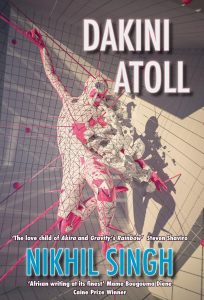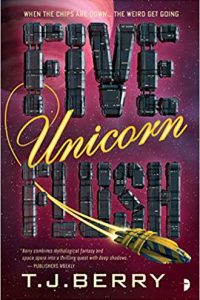Dakini Atoll by Nikhil Singh: Review by Nedine Moonsamy
 Dakini Atoll, Nikhil Singh (Luna Press Publishing 978-1-91555-634-9, £22.99, 252pp, hc) June 2024. Cover by Elena Romenkova.
Dakini Atoll, Nikhil Singh (Luna Press Publishing 978-1-91555-634-9, £22.99, 252pp, hc) June 2024. Cover by Elena Romenkova.
Nikhil Singh has carved out a niche within African SF by bringing the full range of his artistic talents into play in his worldbuilding. The dystopian underworlds explored in his earlier works create the unique effect of falling into a sensorial swamp, an enticing feature that is only enhanced in Singh’s third novel. Dakini Atoll makes for a satisfying sequel to the British Science Fiction Award and Nommo Award nominee Club Ded by offering a neat balance between familiarity and novelty. Club Ded ushers us on to the chaotic movie set of Club Ded, where Hollywood producer Delany Croeser – who echoes Harvey Weinstein’s old-school Hollywood masculinity – frequently abuses and blindsides cast members. As the story unfolds, we learn that Croeser is merely using the movie as a front for the real Club Ded; a watery underworld fuelled by drugs and illicit funders, which serves as a pleasure dome for anyone who can afford it. When Club Ded is eventually exposed, Croeser escapes, and the rest of the cast spin-off in different directions.
Dakini Atoll lives in the wake of Club Ded, which has devolved into a watery scrapyard, a distant memory that haunts the characters who now seek out new avenues for survival. Chief among them is Delilah, a troubled movie star, susceptible to Croeser’s abuse because of her irrepressible need for fame and escapist drugs. Yet while he managed to get away with shamelessly exploiting her in Club Ded, Dakini Atoll ultimately becomes her revenge narrative. Delilah, along with other revisited characters like Fortunato, Chloe, Anita and Trill, all help to break and bend the world that has been made to protect the likes of Croeser.
‘‘Dakini’’ evokes both Buddhist and Hindu traditions, signifying the magnanimity of the divine feminine that evades Western moralising dichotomies of good and evil. Dakinis are demonesses and goddesses who possess the ability to wreak destruction and create worlds anew, and often see these actions as interchangeable. In Dakini Atoll, these ancient schools of thought are reimagined through a posthuman aesthetic as Delilah and Trill willingly give their bodies up for technological and genetic modification. They are refreshingly unsentimental about the destruction of their human form and willingly swap ‘‘pretty’’ for power instead. Singh, without getting too technical, gives a pleasingly scientific rendition of their awe-inspiring evolution into arachnid hybrids, which is rare in the world of African SF, which often relies on more fantastic tropes to realise the same ends. Both Delilah and Trill become reincarnations of the monstrously beautiful Dakini, and by the end they are no longer playing Croeser’s game, but become its chief orchestrators, spinning webs of destruction and creation and, by extension, change. Overall, there is something profound about the way Singh gets us to think about women’s bodies, as it illustrates how for a ‘‘subhuman’’ class in a patriarchal world, the posthuman holds far greater potential for feminine and feminist aims by opting out of the game entirely.
Bearing in mind the heavy influence of Asian schools of thought on the narrative, the hallucinogenic form of Club Ded and Dakini Atoll give the impression of Hindu epic meets cyberpunk. As the only way for characters to seek justice is not against but through chaos. Similarly, readers are left to grapple with Singh’s signature style of frenetic storytelling, which dutifully conveys a sense of the world coming at you too fast. Down to the level of the sentence, the novel exudes a joy in breaking from form; the narrative is delivered in staccato fragments, giving rise to dadaist poetry in prose. Closer to the sense units of film, each sentence reveals a visual frame which is spliced into the next one in quick succession. The effect is like that of Sergei Eisenstein’s vigorous juxtapositions in Battleship Potemkin, leaving readers to make their own connections between the sometimes too dizzying disorientation of the rapid-fire phrasing. Beholden to the pace of action, the novel rarely moves out of this high gear, meaning that characters (and readers) are left no room for introspection and emotion, and lack dimension at times. Yet this lack of sentimentality and interiority provides a glimpse into hyperreal worlds to come, where the scale of digital immersion may cause extensive subjective distortion, and human affect and selfhood become burdens of the past.
Dakini Atoll stands as a celebration of the posthuman and also anticipates the era of the postnational being and writer. It is no surprise that the novel itself rebuffs the category of an African science fiction novel. Both Club Ded and Dakini Atoll give us access to Cape Town and Johannesburg respectively, but these cityscapes become increasingly fluid as characters flit across the globe, placing African landscapes on par with New York, Los Angeles, and Tokyo. More interestingly, as characters become less embodied in the narrative, they navigate space differently. The presence of human holograms and the potential of technological implants convincingly relays an understanding that human geography is deeply limiting.
Like most successful science fiction novels, Dakini Atoll reimagines the world in ways where we begin to see much of our present-day attachments and allegiances as a fleeting condition that is bound to be rendered old-fashioned in worlds to come. While the growing popularity of African SF has made it commonplace for authors to highlight the indigeneity and authenticity of their narratives, Singh bucks this trend through an unwavering insistence on examining African experiences through global and postmodern frameworks. It is definitely worth reading this book to understand a more playful approach to African SF achieves, as I found myself invigorated by the world of Dakini Atoll, asking myself new questions about the future and African SF long after I had put the book down.
Interested in this title? Your purchase through the links below brings us a small amount of affiliate income and helps us keep doing all the reviews you love to read!
Nedine grew up in Mosquito Valley, Lenasia and has lived in places as far flung as Helsinki, Poona and Makhanda since then. Currently, she lives and works in Pretoria, where she lectures on postcolonial literature in the English Department at the University of Pretoria. She also researches contemporary South African literature and science fiction in Africa. The Unfamous Five is her debut novel
This review and more like it in the September 2024 issue of Locus.
 While you are here, please take a moment to support Locus with a one-time or recurring donation. We rely on reader donations to keep the magazine and site going, and would like to keep the site paywall free, but WE NEED YOUR FINANCIAL SUPPORT to continue quality coverage of the science fiction and fantasy field.
While you are here, please take a moment to support Locus with a one-time or recurring donation. We rely on reader donations to keep the magazine and site going, and would like to keep the site paywall free, but WE NEED YOUR FINANCIAL SUPPORT to continue quality coverage of the science fiction and fantasy field.
©Locus Magazine. Copyrighted material may not be republished without permission of LSFF.









